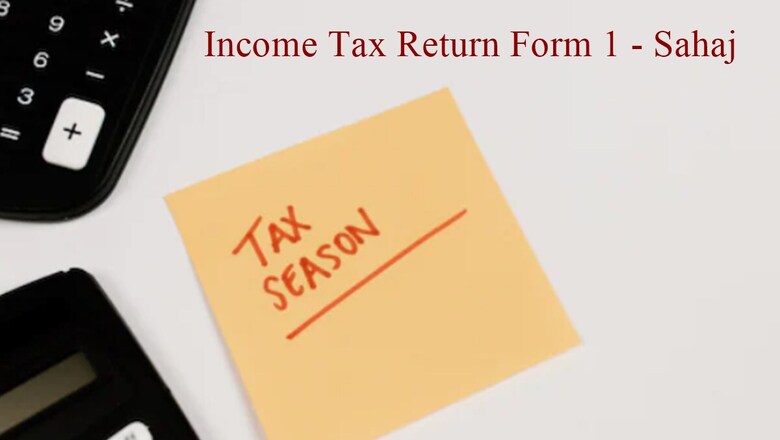
views
An income tax return (ITR) is a document that you file with the Indian tax department to report your income, deductions, and taxes paid for a particular financial year. The process of filing an ITR is known as income tax filing.
The purpose of filing an ITR is to calculate your tax liability for the year and to pay any additional tax that may be due, or to claim a refund if you have paid more tax than you are required to.
In addition to this, filing an ITR is also a legal requirement if your total income exceeds the basic exemption limit or if you have certain types of income, such as capital gains or foreign income.
The finance ministry has allowed individuals against whom search and seizure operations were carried out by the IT authorities to file revised income tax return in ITR-1 form for assessment year(AY) 2023-24. However, there are no substantial changes in the six income tax return forms catering to individuals, professionals and businesses, notified by the Central Board of Direct Taxes (CBDT) on February 10.
This year, CBDT has notified ITR forms 1-6, as well ITR-V (verification form) and ITR acknowledgement form in advance, a move that will give taxpayers enough time to prepare for relevant disclosures. The IT department earlier used to notify ITR forms for the relevant financial year either by March or April.
CBDT has also made certain changes in ITR-1 form with regard to disclosure under Section 139 (1), which is filed voluntarily by persons having annual taxable income of less than Rs 2.5 lakh. These individuals will not be required to intimate in their ITR forms even if their fixed deposits exceed Rs 1 crore.
Who Can File ITR 1 Sahaj?
ITR Form 1 (Sahaj) and ITR Form 4 (Sugam) are simpler Forms that cater to a large number of small and medium taxpayers. Sahaj can be filed by a resident individual having income upto Rs. 50 lakh and who receives income from salary, one house property, other sources (interest etc.) and agricultural income upto Rs. 5 thousand.
Sugam can be filed by individuals, Hindu Undivided Families (HUFs) and firms (other than Limited Liability Partnerships (LLPs)) being a resident having total income upto Rs. 50 lakh and income from business and profession computed under sections 44AD, 44ADA or 44AE.
What Documents Do You Need To File ITR-1 (Sahaj)?
You would need Form 16, house rent receipt (if applicable), investment payment premium receipts (if applicable). However, ITRs are annexure-less forms, so you are not required to attach any document (like proof of investment, TDS certificates) along with your return (whether filed manually or electronically). However, you need to keep these documents for situations where they need to be produced before tax authorities such as assessment, inquiry, etc..
How To File ITR-1 (Sahaj) Online?
The pre-filling and filing of ITR-1 service is available to registered users on the e-Filing portal. This service enables individual taxpayers to file ITR-1 either online through the e-Filing portal, or by accessing the offline utility. This user manual covers the process for filing ITR-1 through online mode.
Prerequisites for availing this service
Registered user on the e-Filing portal with valid user ID and password
Status of PAN is active
Others
Link PAN and Aadhaar
Pre-validate at least one bank account and nominate it for refund (recommended)
Valid mobile number linked with Aadhaar / e-Filing portal / your bank / NSDL / CDSL (for e-Verification)
ITR-1 has five sections that you need to fill before submitting it and one summary section where you are required to review your tax computation. The sections are as follows:
-Personal Information
-Gross Total Income
-Total Deductions
-Tax Paid
-Total Tax Liability
How to Access and Submit ITR – 1 Online?
You can file and submit your ITR through the following methods:
Online Mode – through e-Filing portal
Offline Mode – through Offline Utility
The below steps are to file and submit the ITR through online mode:
Step 1: Log in to the e-filing portal using your user ID and password.
Step 2: On your Dashboard, click e-File > Income Tax Returns > File Income Tax Return.
Step 3: Select Assessment Year and Mode of filling as online, then click continue
Step 4: In case you have already filled the Return and it is pending for submission, click ‘Resume Filing’. In case you wish to discard the saved return and start preparing the return afresh click ‘Start New Filing’.
Step 5: Select Status as applicable to you and click ‘Continue’ to proceed further.
Step 6: You have two options to select the type of Income Tax Return:
-If you know which ITR to file, Select the ITR form; else
-If you are not sure which ITR to file, you may select ‘Help me decide which ITR Form’ to file and click ‘Proceed’. Here the system helps you determine the correct ITR, then you can proceed with filing your ITR.
In case you are not aware which ITR or schedules are applicable to you or income and deductions details, your answers in response to a set of questions will guide in determining the same and help you in correct / error free filing of ITR.
In case you are aware of the ITR or schedules applicable to you or income and deduction details, you can skip these questions.
Step 7: Once you have selected the ITR applicable to you, note the list of documents needed and click ‘Let’s Get Started’.
Step 8: Select the checkboxes applicable to you regarding the reason for filing and click ‘Continue’.
Step 9: Review your pre-filled data and edit it if necessary. Enter the remaining / additional data (if required). Click ‘Confirm’ at the end of each section.
Step 10: Enter your income and deduction details in the different section. After completing and confirming all the sections of the form, click ‘Proceed’.
Step 10a: In case there is a tax liability.
After clicking on total tax liability, You will be shown a summary of your tax computation based on the details provided by you. If there is tax liability payable based on the computation, you get the ‘Pay Now’ and ‘Pay Later’ options at the bottom of the page.
Step 10b: In case there is no tax liability (No Demand / No Refund) or if you are eligible for a ‘Refund’
Click ‘Preview Return’. If there is no tax liability payable, or if there is a refund based on tax computation, you will be taken to the ‘Preview’ and ‘Submit Your Return’ page.
Step 11: If you click on ‘Pay Now’ you can select your preferred bank for making tax remittance. Click ‘Continue’.
Step 12: After successful payment through e-filing portal a success message is displayed. Click ‘Return to Filing’ to complete filing of ITR.
Step 13: Click ‘Preview Return’.
Step 14: On the ‘Preview and Submit Your Return’ page, select the declaration checkbox and click ‘Proceed to Preview’.
Step 15: Preview your return and click ‘Proceed to Validation’.
Step 16: Once validated, on your ‘Preview and Submit your Return’ page, click ‘Proceed to Verification’.
If you are shown a list of errors in your return, you need to go back to the form to correct the errors. If there are no errors, you can proceed to e-verify your return by clicking ‘Proceed to Verification’.
Step 17: On the complete your verification page, select your preferred option and click ‘Continue’.
Step 18: On the e-verify page, select the option through which you want to e-verify the return and click ‘Continue’.
It is important to file your ITR before the due date to avoid penalties and interest charges. The due date for filing ITRs varies depending on the type of taxpayer and the type of income earned. For individuals, the due date for filing ITRs for the financial year 2022-23 (assessment year 2023-24) is usually July 31, 2023, but it may be extended by the government in certain circumstances.
Taxpayers are advised to check the official website of the income tax department (https://www.incometax.gov.in/iec/foportal/) for more details and it is recommended to seek the assistance of a professional or consult for any clarifications or queries.
Read all the Latest Business News here



















Comments
0 comment